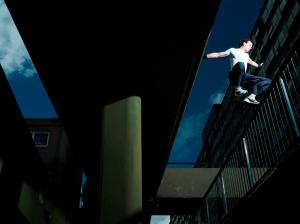 Having confidence in our skills and abilities is vital in the practice of parkour, and yet this is certainly one of the most difficult attributes to develop and maintain. When questioned, most professional or elite athletes will attest to the fact that mastery of their particular discipline – whatever it may be – is 10% physical and 90% mental, or some similar division, so sure are they of the importance of confidence and self-belief. This is doubly true of our own art: with no specialised equipment to fall back on and no safety mats to cushion our falls, all that we have to rely on is our inner fortitude, mental clarity, and the confidence that is born of self-mastery.
Having confidence in our skills and abilities is vital in the practice of parkour, and yet this is certainly one of the most difficult attributes to develop and maintain. When questioned, most professional or elite athletes will attest to the fact that mastery of their particular discipline – whatever it may be – is 10% physical and 90% mental, or some similar division, so sure are they of the importance of confidence and self-belief. This is doubly true of our own art: with no specialised equipment to fall back on and no safety mats to cushion our falls, all that we have to rely on is our inner fortitude, mental clarity, and the confidence that is born of self-mastery.
Self-confidence, however, does not come easily. And once it has arrived, there is no guarantee that it will remain. It is ephemeral, and fragile; easily lost after even one jump failed or an injury received. Like all acquired things it is a skill – something we can choose to develop or allow to dwindle – and to get the most from it we must understand its composition, what feeds or starves it, and how we can best harness it.
Confidence can be compared to the blade of a knife – ignore it and it will dull and grow useless; hone it and it will quickly sharpen, and be able to serve its purpose. It is up to each of us to look into our own minds to sharpen this most powerful of tools, if we are ever to gain the mental edge.
The Structure of Confidence
To begin to gain an insight into self-confidence, we must first understand its structure: this is necessary so that we learn to spot the difference between true confidence and the deceptively similar mental state of self-delusion. To this end, psychologist Jean Garneau has identified that self-confidence involves five main characteristics.[i]
- Prediction: Self-confidence always involves the mental visualisation of success. This is not an innate quality; it is something developed over time through a thorough knowledge of one’s capacity and ability. And, most importantly, these predictions are never absolutely certain – someone with high self-confidence will include a realistic level of uncertainty within all his or her mental predictions.
- Sufficient Skills: When we do something for the first time and enter an unknown situation, we are not able to know all of the consequences of our actions before we carry them out. Self-confidence comes from a reliance on previously developed skills that will enable us to find the solution and overcome the challenge. We cannot know for sure if we will be capable of completing any given task, but a self-confident person can and will trust in his or her abilities to meet it as competently as possible. Without solid skills we are unable to make any prediction with accuracy.
- Realism: Confidence is not blind faith. It is always anchored by a realistic appraisal of the situation and our own abilities, this coming from our own background and experiences. Our body has its own sense of what it is realistically capable of, and vital reflexes such as the startle impulse act as a powerful self-protection system that steer us away from blind or excess confidence. Without this realistic assessment constantly going on within us, even everyday activities would be highly dangerous.
- Specificity: Self-confidence is not uniform across all our activities. It varies according to how comfortable we are with a particular action or task, and so is specific to the challenge before us. Again, this demonstrates that confidence is a skill that can be developed in some areas and left undeveloped in others.
- Transitory: Self-confidence is not a fixed, permanent thing. It must be maintained, constantly strengthened, and even rebuilt at times. We have to keep training and practising in order to sustain it and an absence of new experiences can actually reduce self-confidence. Equally, if the new experiences are negative (for example, an injury) they can erode even a high level of self-confidence.
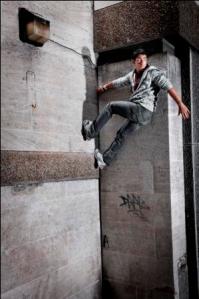 Garneau gives the definition of self-confidence as being ‘always the result of a series of experiences. It is always a partial certainty evolving from a specific context for one moment only’[ii]. In other words, true self-confidence is a flexible, ever-changing thing – it can strengthen or diminish depending on our experiences, which can result in us being caught in either a positive or negative cycle of belief and ability. A positive, successful experience reinforces our self-confidence, which then serves to carry us through the next challenge, and so on. Conversely, a negative or unsuccessful experience can reduce our self-confidence, which then works against us when it comes to the next challenge, increasing the odds of failure which will then reduce our self-confidence further.
Garneau gives the definition of self-confidence as being ‘always the result of a series of experiences. It is always a partial certainty evolving from a specific context for one moment only’[ii]. In other words, true self-confidence is a flexible, ever-changing thing – it can strengthen or diminish depending on our experiences, which can result in us being caught in either a positive or negative cycle of belief and ability. A positive, successful experience reinforces our self-confidence, which then serves to carry us through the next challenge, and so on. Conversely, a negative or unsuccessful experience can reduce our self-confidence, which then works against us when it comes to the next challenge, increasing the odds of failure which will then reduce our self-confidence further.
How then can we build this structure of self-confidence through our Parkour practice and ensure we maintain a cycle of positive reinforcement, without falling into the trap of self-delusion and overconfidence?
Reinforcing the Structure
Now that we have a rough grasp of the make-up of confidence, we can begin to identify just how we can shape our training to strengthen and support its architecture. The methods by which a freerunner can improve his or her self-confidence fall roughly into three broad categories: The Experiential Process, Result Evaluation, and Taking Calculated Risks.
1) The Experiential Process
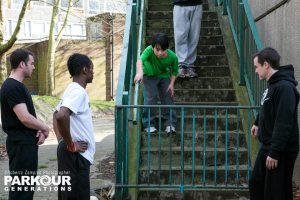 Whenever we do something for the first time, we are unable to feel completely safe because we have no prior knowledge of the consequences of that action and we cannot be sure how best to adapt ourselves to the new context. The more new actions we carry out – and here ‘new’ can refer to a new movement, or a known movement in a new location, or in different light conditions, or any scenario that presents a new variable – the more our confidence grows and with it our ability to judge new situations that occur. This results in relaxation and a lessening of fear and apprehension.
Whenever we do something for the first time, we are unable to feel completely safe because we have no prior knowledge of the consequences of that action and we cannot be sure how best to adapt ourselves to the new context. The more new actions we carry out – and here ‘new’ can refer to a new movement, or a known movement in a new location, or in different light conditions, or any scenario that presents a new variable – the more our confidence grows and with it our ability to judge new situations that occur. This results in relaxation and a lessening of fear and apprehension.
Variety of experience is vital, and the way to achieve this is to repeat the fundamental movements of parkour within as wide a range of situations as possible. This requires constant innovation. Alter the variables as you work on the basics such as balance, strength, flexibility, spatial awareness, etc. – use multiple locations for the same movement, seek out different surfaces and distances, practise even in awkward, tight areas. Work on your touch, your muscular relaxation and your judgement. Think about new angles, new positions, new types of landings and takeoffs. Practise moving from an initial position of imbalance to force yourself to recover and find balance as you move. As you do so, you will find your basic attributes improve noticeably and this in turn will have a hugely positive effect on your confidence in those attributes.
Thus, first and most obvious is the need to undertake new experiences. True self-confidence develops in tandem with your own skills and abilities, and naturally results from a series of experiences that gradually increase in difficulty. This engenders the ‘sufficient skills’ that Garneau refers to. As our skills improve, the better able we are to judge the risks involved in any action; this leads to increased adaptability, so that even in a new context we can feel secure in our ability to manage it.
2) Result Evaluation
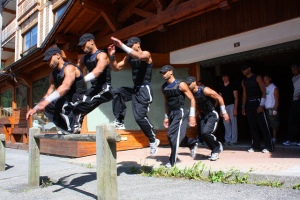 Simply undergoing a series of experiences, however, is not the most effective way to bolster the structure of our confidence. We must also be able to evaluate the results of our actions, so that we might learn how to improve upon our current performance. This requires us to be honest with ourselves at all times, in order to make full use of the feedback our body gives us. In truth only you can know how controlled and intentional any specific action was, so you must run a constant self-appraisal. For example, when you land a precision jump, even if it looks perfect to any onlookers, you may feel a slight imbalance upon landing, or too much muscular tension, or perhaps you did not land exactly where you intended to. Be absolutely honest with yourself, and by evaluating the jump in detail you will be able to improve it next time round.
Simply undergoing a series of experiences, however, is not the most effective way to bolster the structure of our confidence. We must also be able to evaluate the results of our actions, so that we might learn how to improve upon our current performance. This requires us to be honest with ourselves at all times, in order to make full use of the feedback our body gives us. In truth only you can know how controlled and intentional any specific action was, so you must run a constant self-appraisal. For example, when you land a precision jump, even if it looks perfect to any onlookers, you may feel a slight imbalance upon landing, or too much muscular tension, or perhaps you did not land exactly where you intended to. Be absolutely honest with yourself, and by evaluating the jump in detail you will be able to improve it next time round.
And it is best if that ‘next time’ comes immediately. A good method to employ in your training is ‘the rule of three’: this is the training tenet that any action successfully carried out should then be instantly repeated twice more. The first time you do something new you will probably have done it somewhat shakily, and in the back of you mind there remains the concern that perhaps it was a fluke, a one-off, and that next time you may bail horribly! You may have completed the movement, but you were likely unable to experience or ‘live’ it due to being so consciously controlling of your actions. Repeat it and you will reinforce the pattern in your body and mind, and you will be able to relax into the movement and make it more natural. One more time and it will be yours, controlled without anxiety or effort, and you will be able to ‘live’ the movement with confidence. There is a direct relationship between repetition of an action and our confidence with that action so it is important to be disciplined enough to repeat and repeat again.
After repeating a few times, evaluate. Take a few seconds after completing a successful movement to imprint mentally what has just occurred physically. Recalling this state of mind will help you to feel more confident when it comes to undertaking the next challenge. This is a form of visualisation, an inner reinforcement of success that will pay dividends as you progress to more complex situations. As Garneau establishes in identifying ‘specificity’ as one of the characteristics of confidence, the more situations you evaluate, the more your self-confidence will grow in height as well as width.
3) Taking Calculated Risks
 Perhaps most important in the development of a solid structure of self-confidence is the ability to calculate the risk involved in our actions. Everything we do entails risk, even the smallest movements and the simplest techniques: we can injure ourselves slipping from a three-foot high wall or landing badly from a short precision just as easily as we can from a big cat-leap or a complex vault. What separates us from the danger-freaks is the knowledge that we are taking calculated risks, fully cognizant of our capacity to overcome them, along with our facility to make good choices about the risks we take. To explore any new and unusual situation in parkour necessitates the taking of risks, but this does not mean we have to throw ourselves into highly dangerous situations on a regular basis. The risk-factor must be graduated, and initially should remain low until our skill level increases enough for us to move on to more difficult manoeuvres.
Perhaps most important in the development of a solid structure of self-confidence is the ability to calculate the risk involved in our actions. Everything we do entails risk, even the smallest movements and the simplest techniques: we can injure ourselves slipping from a three-foot high wall or landing badly from a short precision just as easily as we can from a big cat-leap or a complex vault. What separates us from the danger-freaks is the knowledge that we are taking calculated risks, fully cognizant of our capacity to overcome them, along with our facility to make good choices about the risks we take. To explore any new and unusual situation in parkour necessitates the taking of risks, but this does not mean we have to throw ourselves into highly dangerous situations on a regular basis. The risk-factor must be graduated, and initially should remain low until our skill level increases enough for us to move on to more difficult manoeuvres.
Self-confidence is so called because it is an isolated skill. It has to come from within you; otherwise it will likely be false confidence which so often leads to failure and injury. Do not be concerned with impressing others or keeping up with the more advanced; just follow your own rhythm and let your confidence build gradually. Take your time – if you don’t feel confident of success, don’t attempt it. The obstacle will not disappear: go away, practise, and come back when you know it is within your abilities.
Equally you may feel highly confident of performing a certain move but an honest appraisal of your abilities might reveal that your body is not yet capable or prepared. Be patient, and do not attempt to rush through the stages too quickly. Again, use the three-tiered approach to any new movement: First, just do it; second, do it well; and third, do it fast and well. This method of progressive training develops a sincere harmony between body and mind, so that one will not fool the other and they will work together not only to achieve your goals but also to keep you safe.
Risk calculation is the means by which we can achieve Garneau’s ‘prediction’ and ‘realism’ characteristics of self-confidence. Understanding the risk inherent in any dynamic action and still being able to complete that action successfully, due solely to our own physical mastery and mental commitment, is the very bricks and mortar from which inner confidence is constructed.
Keeping the Edge
Possessing concrete, realistic self-confidence is what produces the sharpened edge that sets the masters of any discipline apart from the rest. It is not some mystical gift available only to a chosen few, nor is it blind faith in one’s abilities. It is the product of continuous training, of repetition, and of self-analysis. It is a process, and one that has no shortcuts.
Furthermore, the process simply must be tailored to our own individual skill levels and our own individual needs. We need this process, and to make the best progress we need it to be consistent. And it is a process that has no end. There is no ‘achieving’ self-confidence and then forgetting about it, done, finished. It is a state of being that requires constant maintenance and work, just as a blade needs regular honing to remain sharp.
Stop training for a few weeks and you will understand just how easily it comes and goes. It is a transitory thing that can easily slip away unnoticed if our attention wavers, and once gone it must be rebuilt all over again. But hold on to it, develop it like any other skill and keep it sharp, and it will carry you to places you would never have thought possible.
[i] Jean Garneau, ‘La Lettre du Psy’, Vol. 3, No.2, February 1999
[ii] Ibid.
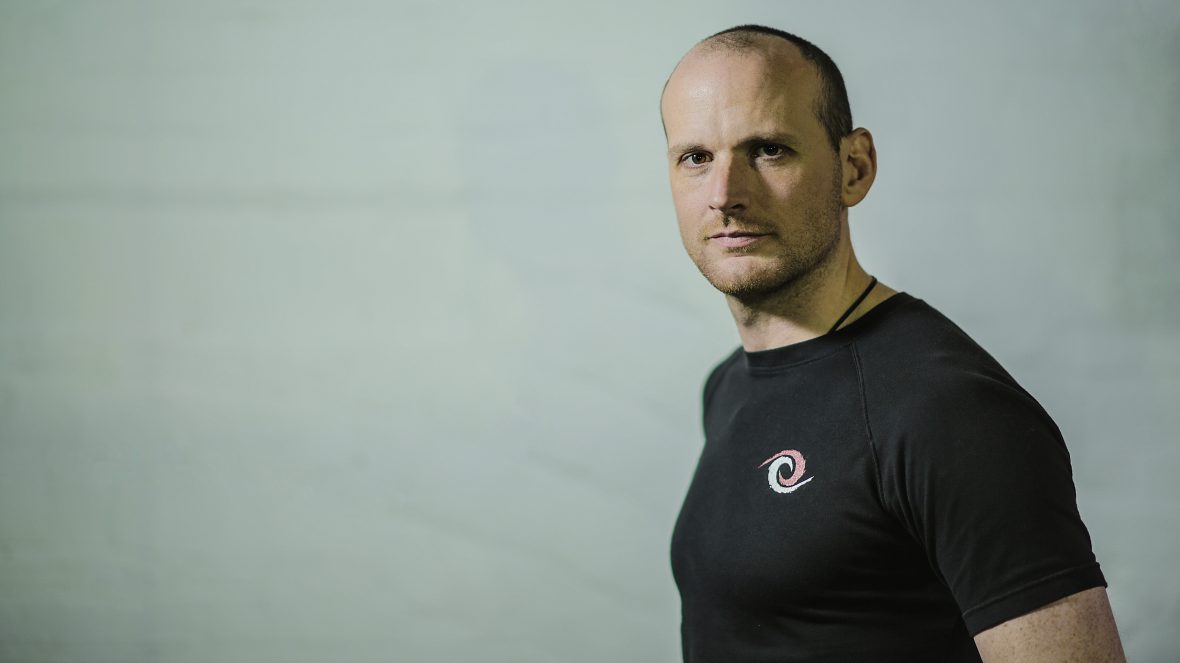


Nice, super useful stuff here. Posting this in my FB groups. One thing I think could have been mentioned is the idea of confidence in ones personal value in general (not just in Parkour). A lot people get really stumped in all areas of life (including parkour) because they doubt their value as a unique human being. Of course it’s a much harder task to help someone gain that type of core overall confidence in just a written article so I understand why it was avoided. I would just like to say though that some people may need to look deeper into their life situation; whats an outdated limiting belief your holding onto, maybe join an intentional transformational program, heal a core relationship, or find a dedicated life mentor if the great advice given here still doesn’t help you out. Anyways thanks for the article.
LikeLike
Thanks Joe, glad you liked it.
LikeLike